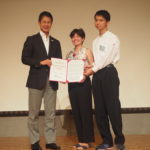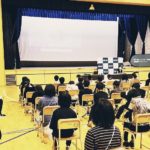Column Outstretched Hands: Reconstruction Support from Overseas
Introduction
When the Great East Japan Earthquake hit on March 11, 2011, information on the disaster made its way around the world through various media outlets, such as TV and the Internet. The great amount of aid, coming not only from within Japan but also from abroad, still sits fresh in people’s minds. When the atomic bomb was dropped on Hiroshima about 70 years ago, the amount of information available was significantly limited, but various kinds of support were delivered from overseas. This “support from overseas” encouraged the struggling citizens of Hiroshima both physically and spiritually.
1 Provision of Pharmaceuticals Soon after the Bombing
Among those who brought support from overseas, Marcel Junod, for whom there is a monument in Peace Memorial Park, is probably the most famous. A Swiss doctor, Junod came to Japan on August 9, 1945 as head of the delegation of the International Committee of the Red Cross (ICRC) to Japan. Although he heard the rumors of atomic bombs dropped on Japan, immediately after the war, he was busy investigating the status of allied prisoners of war. On August 29, Junod dispatched ICRC delegate Friedrich Bilfinger and others to Hiroshima to report on the situation there. On August 30, Bilfinger sent a telegram reporting that the condition in Hiroshima was “appalling” and requested Junod to call on the Allied General Headquarters (GHQ) to send medical aid to Hiroshima as soon as possible. Junod immediately negotiated with the GHQ to provide support to the A-bombed city, and on September 8 he came to Hiroshima himself, bringing along approximately 15 tons of pharmaceuticals and medical equipment provided by the US army, and saved many lives. 1)
2 Writing about Hiroshima
The first news articles on the damages of Hiroshima published overseas were written by a second-generation Japanese-American, Leslie Nakashima, and an Australian journalist, Wilfred Burchett, 2) but the first to conduct thorough interviews with A-bomb survivors and that conveyed their personal stories overseas was Pulitzer-winning American author, John Hersey. Hersey visited Hiroshima in May 1946. He interviewed six survivors including Reverend Kiyoshi Tanimoto of the Hiroshima Nagarekawa Church and wrote the reportage, “Hiroshima,” which was published in the magazine, New Yorker, on August 31 of the same year and shocked the American public. In December, this article was already published in book from Hiroshima vividly conveyed the devastation caused by the atomic bombing to Americans, who did not yet know the situation, and inspired many readers to help send aid to Hiroshima. 3)
Robert Jungk, who brought the story of Hiroshima to Europe, must also be remembered. A Jewish journalist born in Germany, he visited Hiroshima in May 1957; and with the help of Hiroshima city employee, Kaoru Ogura, who worked as a translator, he interviewed many A-bomb survivors. Two years later, he published Strahlen aus der Asche (Children of the Ashes) about a Hiroshima under reconstruction, with two young A-bomb survivors as leading characters. This book drew a huge response in Europe. It also was a means by which the story about Sadako Sasaki and the thousand paper cranes was introduced to the world. 4)
3 Building Homes for the Survivors
We must also not forget Floyd Schmoe, the American who worked to build houses for those who lost their own homes in the atomic bombing. Schmoe, a devout Quaker and lecturer at the University of Washington came to Hiroshima in August 1949, when he was 54 years old. In August of 1945, Schmoe heard the news of the bombing while in Seattle and was so heartbroken that he felt as if he himself had been struck by the bomb. 5) He wrote, “To us who came here to build homes for homeless people as a token of our regret and humiliation….” 6) With a heavy heart and a feeling of guilt, Schmoe decided to build houses with his own hands, for those in need, and began fundraising in the United States, finding collaborators, and headed to Hiroshima in 1949.
Working along with Japanese volunteers in Hiroshima, Schmoe built four housing units over the course of three months, and provided them to four families. He continued thereafter to lead the construction of “Houses for Hiroshima” and by 1954 this project had also built 16 housing units and one community center in Ushita and Eba and supported the survivors in a difficult situation. 7) In 2012, the only remaining “House for Hiroshima” opened as the “Schmoe House, “ a branch of Hiroshima Peace memorial Museum.
4 Healing the Emotional Trauma of the Survivors
In March 1964, the City of Hiroshima praised the achievements of Norman Cousins from the United States for his peace activities, including physically and morally assisting children orphaned by the atomic bombing, and awarded him the title of “special honorary citizen.” There is a monument honoring Cousins in Peace Memorial Park, and even today there may be people who still clearly remember the role he played in the reconstruction of Hiroshima.
Cousins was the editor-in-chief of the, Saturday Review of Literature magazine, and came to Hiroshima for the first time in August of 1949. Visiting a war orphanage, he was shocked by the plight of the A-bomb orphans, and upon returning home soon gave a report on the situation in his article titled “Hiroshima – Four Years Later.” In this article, he proposed the idea of moral adoptions of children who had lost their immediate families by the A-bomb in order to support them as they grew up. He gained many collaborators from the United States and with their contributions, supported around 500 orphans. 8)
Another achievement of Cousins was opening the way for female A-bomb survivors to get medical treatment in the United States. The women who had keloid scars from the atomic bombing were deeply hurt by people’s stares and words. They became more and more negative and even hated going outside. 9) In September 1953, Cousins came to Japan for the third time, and he was able to meet ten female survivors through an introduction from Reverend Kiyoshi Tanimoto. This led hime to invite female survivors to receive medical treatment in the United States. Through his devoted efforts and the support of American doctors, Christians and other private people, he was able to prepare the funds needed for their operations, transportation and accommodations. He also prepared places for them to stay, and in May 1955, 25 girls headed to the United States. 10) They were called the “Hiroshima Maidens” and their scarred bodies of them brought the terrible reality of the atomic bomb to the American public. During their stay, a bilingual second-generation Japanese-American who accompanied them as a translator, Hatsuko Yokoyama (Helen Yokoyama), encouraged them, as they were in unfamiliar environment of foreign country and were anxious about the surgeries. 11) The 25 girls underwent plastic surgery at Mount Sinai Hospital in New York to remove the keloid scars on their faces and bodies. By the time they returned home in November 1956, they had undergone over 100 surgeries.
In Closing
After the war, the majority opinion of the public in the United States saw the atomic bombings as justified, but as we have seen here, many Americans supported Hiroshima in various ways. Feelings of guilt caused from being citizens of the country that dropped the bombs along with their human consciences led them to take actions for Hiroshima. When we recall their efforts, we must also not forget the actions of Kiyoshi Tanimoto, Kaoru Ogura, Helen Yokoyama, and others who served as go-betweens, helping to strengthen the will of the supporters and encouraging their actions.
(Hitoshi Nagai)
Notes and References
1. Junod, Benoit. Marcel Junod : un “troisième combatant”. (Okawa, Shiro. trans., Maruseru Juno – Hitori no “Dai San no Heishi” Toshite. Aichi Daigaku Hogakubu Houkeironshu: Dai 166 go. December, 2004: pp. 70-74.) Junod, Marcel. Warrior Without Weapons. (Maruyama, Mikimasa. trans., Dokuta Juno no Tatakai zoho-ban. Keiso Shobo, 1991: pp.263-275.)
2. Nakashima’s article dated August 30, 1945 was published in the Honolulu Star-Bulletin, and Burchett’s article was published in the Daily Express on September 5, 1945. Nishimoto, Masami. “Hiroshima Daden Dai Ichi go” (The First News Dispatch from Hiroshima). Chugoku Shimbun, October 5, 2000 edition.
3. Tanimoto, Kiyoshi. “Shohan Yakusha Atogaki”. In Hersey, John. Hiroshima. (Ishikawa, Kinichi; Tanimoto, Kiyoshi; Aketagawa, Toru. trans., Hiroshima: zoho-ban. Hosei University Press, 2003: pp. 211-219.)
4. Hiroshima Peace Memorial Museum & Jungk Kaken Research Group. “Hiroshima o Sekai ni Tsutaeru – Kaku no Higai Naki Mirai wo Motomete” (Telling the World of Hiroshima – In Search of a Future Without Nuclear Disaster). Hiroshima Peace Memorial Museum, Jungk research group, 2013: pp. 4-5, (Robert Jungk 100th birth anniversary exhibition of materials and related documents). Ogura, Kaoru. Hiroshima ni, Naze – Kaigai Yori no Manazashi (Why Hiroshima – views from overseas). Keisuisha, 1979: pp. 41-60.
5. Ibid., pp. 8-9.
6. Schmoe, Floyd. Japan Journey. The Silver Quoin Press. 1950: p. 9. (Ohara, Miyao. trans., Nihon Insho Ki – Hiroshima no Ie. Hiroshima Peace Center, 1952: p.22).
7. Ogura. op. cit.
The Society for the Remembrance of Floyd Schmoe’s House for Hiroshima Project (Ed.). Heiwa no Ashiato – Shumo-san no “Hiroshima no Ie” (Footprint of Peace – Schmoe’s “Houses for Hiroshima”). Private printing, 2007.
8. Kondo, Hiroko. Hiroshima, Rokuju Nen no Kioku (Hiroshima, 60 Years of Memories). Tokuma Shoten, 2009: pp. 91-93.
9. Ibid., p. 60 – 65.
10. Tanimoto, Kiyoshi. Hiroshima Genbaku to Amerikajin (Hiroshima’s Atomic Bomb and Americans). Nippon Hoso Shuppan Kyokai, 1976: pp. 174 – 180.
11. Harada, Tomin. Heiwa no Shunkan (Moment of Peace). Keiso Shobo, 1994: pp. 70 – 71. Nishimoto, Masami. “Genbaku Otome – Kensho Hiroshima 1945 – 96 (6)” (Hiroshima Maidens – History of Hiroshima 1945 – 95(6)). Chugoku Shimbun, February 26, 1995 edition.







